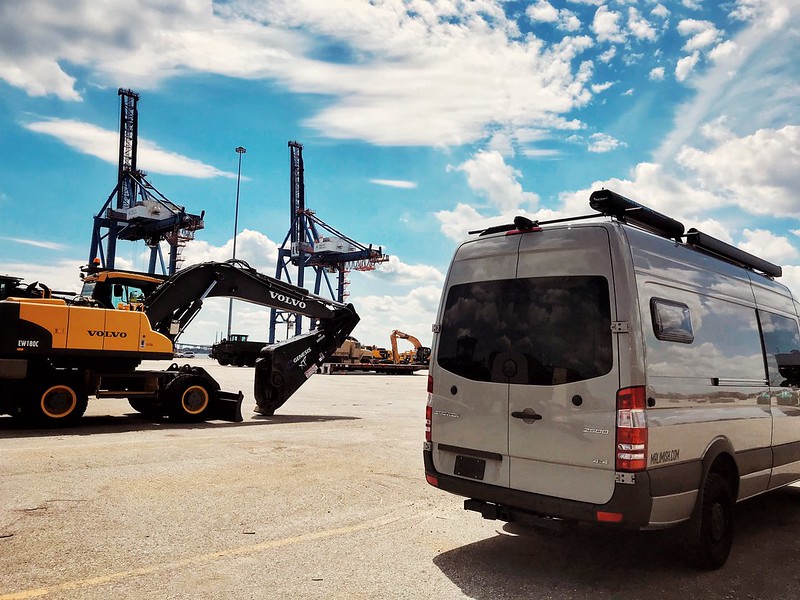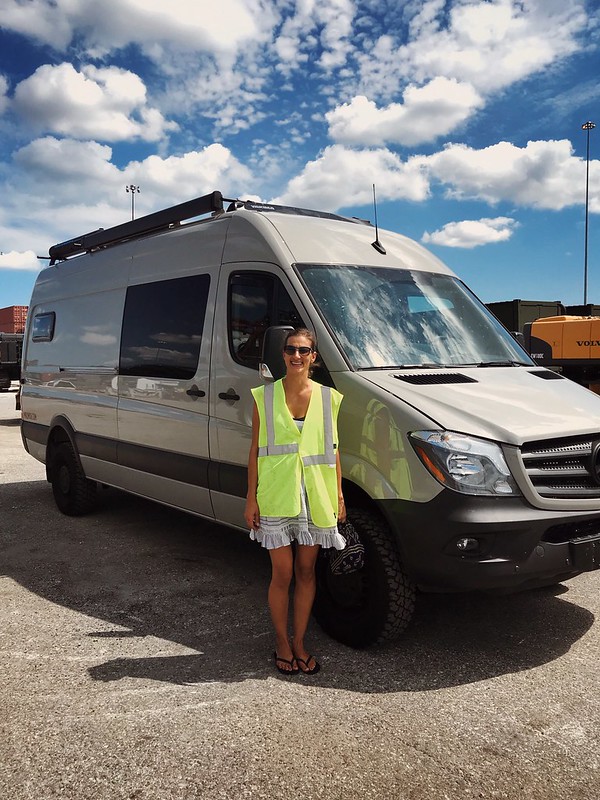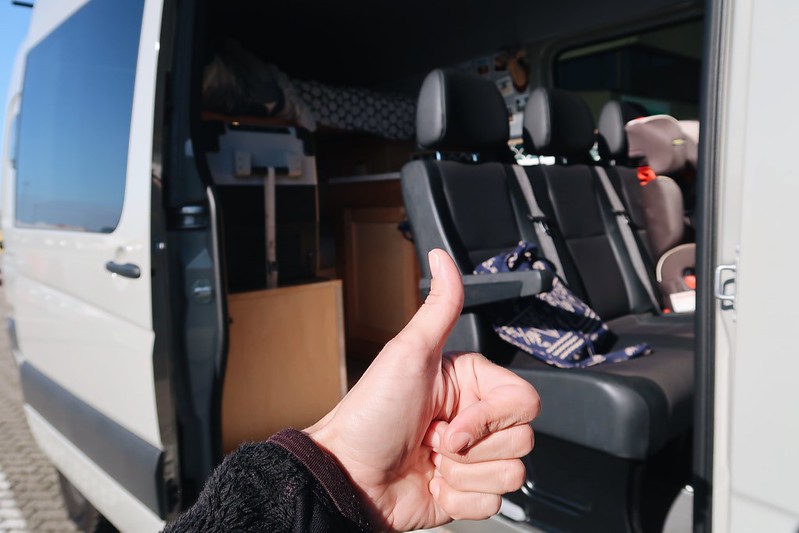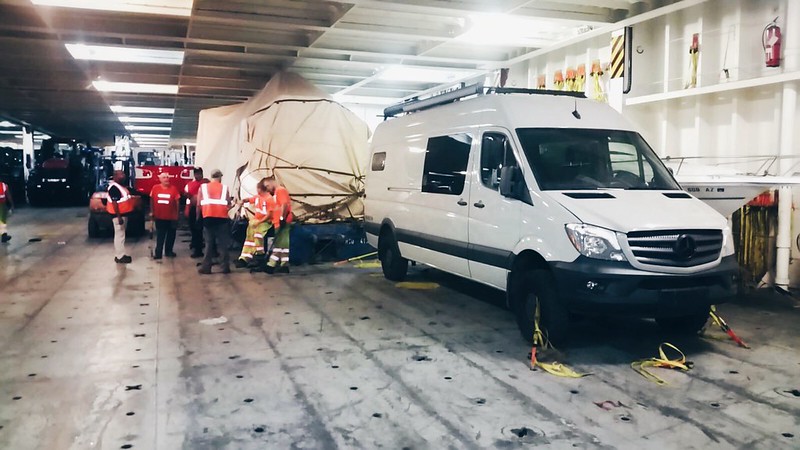Update: In the Spring of 2022, we shipped our van back to the US from Europe. See all details at the end of this post.
In September 2018, we shipped our van from the US to Europe to order to continue our traveling adventure on a new continent. Here is how we did it, step by step.

QUOTES
Contacting shipping agents for quotes is the first thing we did. You can not directly work with shipping company so an agent is necessary. Not everyone will reply to your quote request, probably because you are small beans compared to the thousands of cars they ship for companies daily. You will also want to get several quotes because pricing can vary. The quotes you receive will be based on the dimensions and weight of your vehicle and also your port destinations. We ended up going with Wallenius Wilhelmsen Logistics.
Regarding port destinations, we chose to drive across the US from the west coast to the east coast to ship our van to lessen the amount of fewtime our van would be on the ship and to limit the number of port stops. The reasons for that is to have less chance of delays due to increased stops and also to have minimal chance of theft at each port.
SELECT AN AGENT
Once you select a shipping agent, the agent will need a few things from you in order for them to reserve a spot on a ship for you. Our agent required us to fill out a shipping form and a power-of-attorney form. We also had to send copies of our passports and a copy of the title to our vehicle. In addition to those items, we had to apply for an Employer Identification Number (EIN) via the IRS website. The agent had paperwork for me to follow and it was pretty straightforward.
*Please note: Whoever fills out the paperwork above will need to be the person who delivers the vehicle at the port. Only ONE person is allowed at the port with the vehicle. I did not know this ahead of time and was in charge of it all while Dan and the kids waited at a hotel lobby a couple of miles away.
Once those required items were received, the agent gave me some shipping date options based on the date range I provided and on the ports I hoped to ship from and to. Once I selected a shipping date, the agent told us to expect our ‘dock receipt’ for our selected ship in about a week via email. The dock receipt is the main document needed to secure your spot on the ship.
PORT DELIVERY DATE AND OPTIONS
Once we received our dock receipt, we also received an email stating when the latest date is to have our van at the port. Our date for delivery to the port was 7 days prior to our shipping date. The port is closed on weekends so plan accordingly.
In addition to a delivery date, our agent also gave us a few options for how to get our van to the port. We could:
- Hire a port escort to personally take us and the van thru the port delivery process together.
- Drop off the van at the port with a company that will go thru the entire process for you.
- Have a trucking company pick up your van from your location of choice and then will go thru the entire process for you.
We chose option #1 for two reasons. It was the cheapest and we wanted the piece of mind that our vehicle (which is our home) made it to where it needed to be safely. Hiring a port escort cost us $100 and we scheduled ours a few days prior to delivery. The escort we chose was the recommended escort we got from our shipping agent.
VEHICLE PREP
The shipping agent will give you a list of rules to follow to help get your vehicle ready for its journey overseas. Here are some of the highlights:
- Quarter tank of fuel or less.
- Empty inside.
(Disclaimer: Ours was not empty. It was full of our stuff which we knew had a chance to disappear during shipping but there is no way we could empty out all of our belongings and carry it with us. We took a risk and it all worked out. We also had everything locked away and out of sight, except for our bedding and a few water jugs. - No propane.
- Free from dirt (outside and inside).
PAPERWORK PREP
Prior to delivery day, we had to have our documents in order. We had to make sure we had 5 copies of the title, 5 copies of the dock receipt, the original title, and our passport.
ACTUAL DELIVERY OF VEHICLE TO PORT
We dropped off our van at the port 7 days prior to the ship’s sailing date. It was a requirement as the shipping company needs the time to prepare the loading order for all the vehicles. Below are the steps we took to deliver the van to the port. There might have been a few extra steps for us due to tighter security based on our shipping location’s close proximity to Washington, DC. The entire delivery process took an hour.
- We met our port escort outside of the port at a pre-determined location.
- I handed all of our paperwork to our port escort, in addition to $100 in cash for his services. This fee can vary based on who you use and what they do for you. But it should not be too excessive.
- He quickly inspected our vehicle and suggested we remove our surfboards from the roof rack and place them inside on the bed, which we did, in order for us to not raise any unnecessary customs red flags during delivery.
- I followed the port escort’s car into port with our vehicle.
- At the port entrance, I handed my driver’s license to the port escort who then got me a port pass.
- The escort gave me my port pass and ID back.
- We drove to the next booth where I got my port pass checked with my ID.
- We drove to the police inspection area where they did a visual check of the interior of the van.
- We drove to customs where our escort gets our paperwork sorted with them.
- We drove to the ship terminal to check in with the shipper. The port escort handed me a safety vest that I was required to wear while inside the port.
- We then follow a worker from the shipping terminal to our vehicle’s parking spot inside the terminal.
- I removed both license plates and took them with me. This was recommended so as to not risk having them stolen.
- I handed my key over to the worker.
- I left my van unlocked as instructed.
- The worker handed me a stamped dock receipt (which you need at the time of pick up).
- Left the port in the port escort’s car and returned my port pass at the port’s exit.

WHILE THE VEHICLE IS IN TRANSIT
After our van was loaded onto the ship, we made payment to our agent for their services. All of this was done online or over the phone. We never met the agent in person. A week prior to pick-up, a forwarding company also contacted us to set up a pick-up date and time. This forwarding company worked with our shipping agent so they made contact with us. The forwarding company required a few things from us. We needed a written statement to inform customs that we shipped our vehicle to Europe for holiday purposes only. We also had to provide a copy of our title, a copy of our passport, and proof of liability insurance. (For liability, we used www.tourinsure.de)
Also while waiting for our van to get loaded onto the ship, our shipping agent gave us a link to follow the ship’s route via a special website. It was pretty barebones so Dan found a marine ship tracker website (www.marinetraffic.com) that allowed us to follow via GPS coordinates to know its exact location during the entire journey.
PICKING UP THE VEHICLE
We scheduled a time to pick up our van via email with our forwarding company. Just like with the port escort, our forwarder picked me up at a pre-determined location right near the port and I paid him cash for his services and pick-up fees. We drove straight into the port and directly to the shipping terminal this time with no special procedures or checks. Our van got cleared by customs the day before our scheduled pick-up date. That saved us a lot of time at pick-up. Once at the shipping terminal, the forwarder requested my van and within minutes, a worker went to retrieve it from the yard. Once they brought our van out of the yard and into the parking lot, I personally inspected the van for damage. Luckily nothing was damaged and I signed paperwork releasing the van and stating that it had no damage. And that’s it. Then I drove away and began our European adventure. WOOHOO!!

COST
Shipping agent = $1,739.00
Port Escort =$100.00
Forwarder = $750.00
TOTAL = $2,589.00
TIMETABLE
Everyone who ships their vehicle overseas says there are always delays. We chose departure and arrival ports that would only involve one extra stop and thus decreasing our chance of delays but delays still occurred for us.
Our ship was scheduled to leave the port of Baltimore, Maryland on 9/7/18 and it did leave as scheduled.
Our ship was scheduled to arrive at the port of Zeebrugge, Belgium on 9/18/18 but it arrived on 9/23/18. Due to customs clearance, our pick-up date was actually 9/25/18. The delay was caused by a couple of extra stops added to the shipping route after the booking was made.
PORT SELECTION
We chose the port of Baltimore, Maryland because it was supposed to be the last port in the US before heading across the Atlantic.
We chose the port of Zeebrugge, Belgium because it was the first port after a quick stop in Germany. It was easier for us to ship into Belgium rather than Germany because of temporary import rules and fees. We were told that Germany requires a hefty deposit for any temporary imports in case the owner chooses to not ship the vehicle back.
CONTACT INFORMATION
Shipping Agent:
Megan Alexander
Seabridge Lamprecht
800 S Conkling St
Baltimore, MD 21224
Phone: (410) 633-0550
Fax: (410) 633-0556
http://www.seabridgelamprecht.com
Baltimore Port Escort:
Remie Danielson
TWIC Baltimore Port Escort Service
(410) 591-3019
Forwarder:
Patrick Rubenska
Bentri Forwarding Bvba
+32 (0) 3 237 97 13
+32 (0) 472 88 29 77
www.bentri.be
FUN FACTS
Because our van had our blog displayed on its sides, the longshoremen who loaded our van sent us photos of our van secured in the ship days before our shipping agent confirmed it was on a ship at all. Haha.

UPDATE: SHIPPING BACK TO THE US FROM EUROPE
Shipping back to the US from Europe had a few hiccups. Our van was stuck at the port of Zeebrugge for over a month due to shipping issues and logistics in the spring of 2022. Even though the ship sailed for 9 days, we had to wait for six weeks for it to arrive, which meant a lot of hotel time (and money) while we waited. The cost also jumped to $4000, sans insurance. We tried to use a popular overland shipper to get us back to North America but had to switch back to our original shipper because they guaranteed us a spot after a month of waiting. In hindsight, we should have waited in Europe until our van was on the ship because it was cheaper to stay in Europe than on the East Coast. But we couldn’t because one of our passports was expired and the airlines were allowing us to fly with it on a tight timeline that was about to expire. But once we got our van, it was just as we left it. No issues.
THANKS FOR READING!
Let us know if you have any questions, Marlene.
We also recorded a podcast episode with our friends Jason and Angela from Bodeswell.com who also shipped their van to Europe. If you’d like to listen to more details, click here to give it a listen.



16 Comments
Tammie · November 9, 2018 at 10:47 am
Very interesting and informative! The logistics could be overwhelmingly complicated, but you were our own escort through the process. Thanks, Marlene! Looking forward to the next Mali Mish adventure!
Gary · December 29, 2018 at 6:50 pm
Thanks so so much, we are dong this soon and it was great info!!!!!!
Zoe · March 22, 2019 at 8:23 pm
Do you recall where you stayed near Zeebrugge the night before pickup? I will be picking up our RV at the port there and we need nearby accommodation that is accessible to an 8m long vehicle.
dan · March 23, 2019 at 5:53 am
Hi Zoe, we stayed in an AirBnB in Oostende. It is a short train ride away from Zeebrugge and a longer ride away from Brussels. Our van is a little less than 7m and were able to find parking on the street but it wasn’t free.
Tara · June 10, 2019 at 7:20 pm
Thank you so much for such a thorough posting. I’ve heard you need to have your van insurance for Europe already set up before you ship. This info has actually been harder to find. Would you mind sharing how you chose your van insurance in Europe. I think it’s frontier insurance you need correct?
Dave Ness · August 5, 2019 at 7:14 am
Thank you so much for the detailed account of your shipment. It has inspired me. Did you have to do anything special to be able to drive the vehicle in Europe? I see that you got liability insurance but did you need to do anything else? Did you put your US plates back on the car or leave them off?
Lisa · November 21, 2020 at 6:55 am
So helpful Thank you so much for sharing all this detailed information!!
Tim · December 29, 2021 at 1:40 pm
One of the best shipping blogs I’ve read
Kristen · April 11, 2022 at 9:10 am
We just shipped our van to Barcelona- what company have you used for car insurance while you have traveled around the EU?
marlene · April 11, 2022 at 9:21 am
Hi. I linked it above. We use tourinsure.de for liability. It only covers countries in the EU and UK (for US plated vehicles). All other countries, we buy insurance at their borders.
Clara · January 17, 2024 at 2:20 pm
Hi Marlene
I’m wondering if you have any build out advice for Americans headed to Europe with their vans.
I’ve enjoyed watching your videos. I know this is an old post, but you guys seem to really know what’s going on.
I am in the planning phases of a van build out here in the states. After a year or so traveling around North America I plan to head to Europe and travel around Europe, the European Union and Eastern European countries, Turkey etc any place that’s safe and accessible via van.
I’m wondering if you have advice on electrical systems or shore power plugs placement anything like that that would be wise to incorporate in the original build and not have to modify on the road.
I plan to have a beefy solar system, decent sized lithium ion battery, and an inverter.
Many of us have a tendency I’ve been told that they use 2:30 in Europe so I’m not sure how you guys handled that or if you stayed completely off grid? I’d like to have the option for sure power and it just seems smart to do it at the beginning.
I also know that they tend to have their black water cassette toilet friendly So I’ll probably go with a cassette system or a dry one not sure about that.
Wondering what other things might be an issue that needs to be prepared for in advance.
Many thank yous
Jason Barber · June 9, 2023 at 4:18 pm
Kristen, Are you traveling with your van in Barcelona or moving there with it permanently? We are moving to Barcelona next summer and trying to determine if we should bring our van with us.
Andreas · May 25, 2023 at 6:02 pm
Thanks for the play-by-play! My plans are similar (driving from CA to the East Coast or Canada), and shipping to Belgium. How did you handle car insurance while in Europe? – did you discontinue your US insurance, or is there a ‘dormant’ option?
Yianni · December 12, 2023 at 6:22 pm
i’m trying to do this myself and am having a hard time finding full coverage. liability insurance seems easy to obtain. any info out there?
Mali Mish – Saying hello to Europe and goodbye to Yoda the cat. · November 23, 2018 at 6:19 am
[…] off our van at the port for shipping overseas to Europe (link to how we did it here and here and here), we packed up our stuff and headed to a hotel for a couple weeks. We packed up whatever was […]
Exploring Europe with an American-plated vehicle – Freely Roaming · May 8, 2023 at 12:53 pm
[…] is a blog post about shipping our vehicle to Europe from the US and vice versa. We also have a video and podcast […]